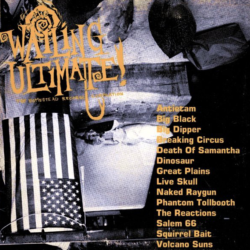The Compilations That Made Us
by Ayersian, August 6, 2020
The Wailing Ultimate
(1987, Homestead Records)
THEN
College in the mid ’80s was a life changer for me in countless ways, but the musical renaissance I went through will always rank at the top. In junior high and high school, I obsessed over what is now classic prog: Rush, Yes, ELP, Pink Floyd, and the like. Once I stepped onto campus, however, there was a new sound—and new people—that turned my brain upside-down: college rock or, later, indie rock. Of course I’d heard R.E.M. and Hüsker Dü before, but it wasn’t until my girlfriend’s sister gave me a dubbed cassette copy of The Wailing Ultimate that it really gelled in my memory. I’d never heard or heard of any of the bands on it—Homestead Records sounded grassrootsy enough—and it immediately went into heavy rotation.
Dinosaur’s “Repulsion” opened the album with a cascade of smothering chordage and slacker vocals. I really dug the Go-Go’s vibe of Salem 66’s “The Well”: a well-constructed song with jangly guitars and solid, metronomic drums. More female vocals followed on Live Skull’s “Fort Belvedere” and its Killing Joke-esque aesthetics. Phantom Tollbooth’s “Valley of the Gwangi” was really fast, had a mystical title, and mentioned The Day of the Triffids in a verse, which fascinated my young sci-fi mind. Breaking Circus’ “Song of the South” was a sneer at the old South with a chorus of “In high cotton!”, while Big Black’s robotic “Il Duce” reminded me of a darker, harsher Devo. Squirrel Bait’s “Sun God” took the jangle-rock to new levels with great vocals that reminded me of Dramarama, and I loved the chorus and rambunctious energy of Big Dipper’s “You’re Not Patsy.” Naked Raygun’s “I Remember” is a souped-up punk romp with gutsy vocals, urgent and convincing in their delivery.
Death of Samantha’s “Blood and Shaving Cream” began with a movie sample, which made it stick in my head for decades, waiting until I saw that movie and connected the dots. The singer reminded me of The Cure, and the noodly guitar solos were cool within the context of the song. Another female-fronted band, Antietam belted out “In a Glass House,” but this song was more experimental like Jefferson Airplane but with more jazz/funk interplay between the guitars and bass. Great Plains’ “Letter to a Fanzine” was an instant favorite with its tongue-in-cheek refrain, “Why do punk rock guys go out with New Wave girls?”, plus they name- checked Homestead, 4AD, and SST Records in the verses in the most hilarious way (“You like everything that comes out on SST, I like almost everything that comes out on Homestead!”).
Great Plains’ “Letter to a Fanzine” was an instant favorite with its tongue-in-cheek refrain, “Why do punk rock guys go out with New Wave girls?”
NOW
I didn’t have the original liner notes, so I didn’t know at the time that so many bands (four out of the fourteen on the comp) hailed from Massachusetts: Dinosaur, Volcano Suns, Salem 66, and Big Dipper. Of course Dinosaur changed their name to Dinosaur Jr. and ruled the alternative rock market alongside J Mascis during the ’90s. Volcano Suns was originally formed by then-former Mission of Burma drummer Peter Prescott, who himself was associated with Birdsongs of the Mesozoic. (I discovered both MoB and BotM on Rykodisc’s Steal This Disc 2 in ’88 but never knew the connection because, well, no internet.) Big Dipper was formed by two former members of Volcano Suns.
Phantom Tollbooth guitarist Dave Rick and producer Chris Xefos would move on a few years later to join King Missile with John C. Hall. I never realized that Big Black used a drum machine and, in essence, foreshadowed the industrial rock/metal genre. Several members of Naked Raygun were also in Big Black, and of course, founder Steve Albini became a household name after producing Nirvana several years later. Later in their career, Live Skull was joined by Thalia Zedek of Uzi and Come, and some of their records were produced by Martin Bisi, who opened BC Studio in Brooklyn with Bill Laswell and Brian Eno in 1979. Bisi became a much sought-after producer after he recorded Herbie Hancock’s Grammy-winning “Rockit,” and went on to produce Helmet, White Zombie, Unsane, Cop Shoot Cop, and Boredoms. Members of Squirrel Bait later played in Bitch Magnet, Gastr del Sol, The Lemonheads, The Breeders, and arguably the most influential of said groups, Slint, godfathers of the post-rock movement.
After this compilation, I bought albums by Dinosaur Jr., Volcano Suns, Squirrel Bait, Big Black, Naked Raygun, and Big Dipper. The Wailing Ultimate still sounds as fresh and insistent as it did in the late ’80s, before the grunge movement permeated the music industry. More than half of the original bands went on to prominent groups, and—lucky for us living in a reunion- happy era—we might even get to see them play live again, after three decades!


